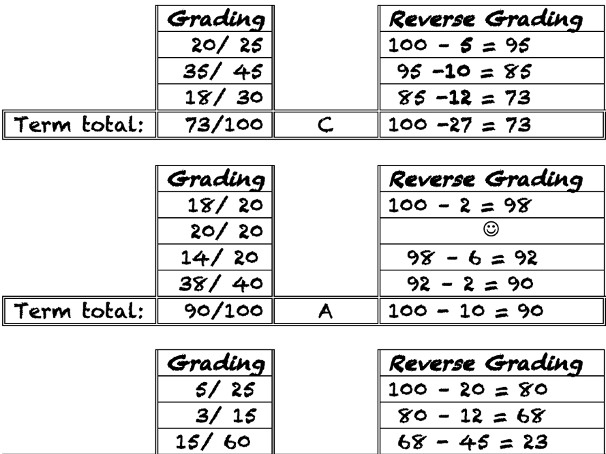
From grading grind to peace of mind: preventing midterm marking meltdown

You may also like
Fourteen years later, I still remember the panicked feeling that overcame me when, as a teaching assistant, I received my first stack of 125 Introduction to Psychology exams to grade. I couldn’t envision how to tackle the mountain of marking that lay in front of me.
With increasing and competing priorities, we must reflect upon and amend our grading philosophies and practices for more efficient and sustainable grading.
Mark my words: manage student expectations
You can lessen grading pressure by being clear and transparent about when students can expect grades to be returned and with what depth of feedback. I usually warn my students that my written feedback may be briefer than they’d like, but that it is done to encourage them to exercise student autonomy and initiative to seek further guidance. If you will be delayed in returning grades, let students know as early as possible, just as we expect that same open communication when students ask for extensions. Being upfront will reduce disappointment or confusion for students.
Goldilocks grading: provide just the right amount of feedback
The “diminishing returns” principle highlights that there is a point where feedback becomes saturated, and that adding more will yield minuscule improvements. With this in mind, concentrate on high-impact comments or focus correction areas (FCAs), rather than exhaustive coverage. Centre feedback around a few key areas that students can feasibly improve on from the current assessment to the next. Also, emphasise how students can successfully achieve the learning outcomes and the skills they need to succeed in this and future courses, as well as the workplace.
For example, last year, I asked myself if it was imperative for my teaching assistant to spend time assessing APA formatting of papers for our 150 students. We stopped allocating grades specifically for APA formatting, but we may apply predefined penalties for gross errors. If we overwhelm students with excessive feedback, it may demotivate some who feel it is impossible to make improvements based on the large amount of feedback. Less is more!
It is also important to consider whether summary comments at the end of the assessment are sufficient or if in-line comments are necessary for the type of assessment and time in the semester (for example, summary comments may be sufficient for end-of-term assessments).
Another method to reduce grading load that also enhances self-directed learning is to frame feedback as reflective questions that encourage students to identify correct answers or best approaches moving forward, instead of you directly telling them.
- Will AI revolutionise marking?
- A step-by-step guide to designing marking rubrics that will save hours of time
- Making feedback effective for your students and efficient for you
Beat the clock: use your time wisely
The most helpful strategy I have personally used to manage my grading load is to divide the total hours I can dedicate to grading by the number of students to determine how much time I can spend grading each assessment – and setting a timer to stick to it! For example, if you can set aside 10 hours over a weekend to grade 30 papers, you can set a 20-minute timer for each paper. This keeps you focused and may prevent feedback from getting too granular.
On another time-related note, it is best to complete grading during the time of day when you have the most mental clarity and energy. For some, it may be first thing in the morning. For others, the afternoons or evenings are when they work best. Additionally, remember to pace yourself! Grading is usually a marathon, not a sprint!
Another useful strategy is batch-grading similar assessment components to limit task-switching. For instance, when grading short-answer test questions, I sometimes grade all answers for question 1, then question 2, and so on. This method allows me to focus on one thing at a time, and not constantly switch between topics, which uses more mental energy.
Tool time: explore a variety of feedback mechanisms
Developing marking rubrics can reduce grading loads because they provide clear and consistent grading guidelines, and some comments are already captured in the rubrics. However, it is important to choose the right type of rubric for the assessment. There are three main types of rubrics:
- Single-point rubrics are good for low-stakes assessments and skills demonstrations
- Analytic rubrics are best used for formative assessments where students would most benefit from detailed feedback or for assessing skill development needed for your course, future courses or the workplace
- Holistic rubrics are useful for summative assessments that measure overall competence and mastery, final drafts of assignments and creative or abstract tasks.
Audio and video recordings are additional feedback mechanisms that can save you time and add a personal touch that students will appreciate. You can use screen recordings when there is complex feedback to share, or when you need to show a method or process. When you must use written notes, consider using voice-to-text software or developing a comments bank with the most common issues you see in graded work that you can then copy and paste into student assessments. You can also use text expansion tools to cut down on the time it takes to write comments from scratch.
Self- and peer assessments can also reduce your grading strain. Students can self-assess their work and you can verify grades or use their comments to arrive more quickly at a grade. This method encourages students to develop metacognitive skills such as self-reflection and critical thinking.
Alternatively, students can complete peer reviews or collaborative assessments. They can learn a lot about their own strengths and gaps in learning when assessing peers. This can be accomplished using partners or small groups where all members must reach a consensus on grading decisions.
Ctrl + alt + grade: make technology your friend
Are you using your school’s learning management system or GenAI to its fullest?
- Explore the settings of your online grade centre for more efficient grading (for example, you can hide grades until all assessments are graded or automatically keep final grades updated)
- Add automated flags to identify students who are falling behind and would benefit from more detailed feedback
- Use auto-graded quizzes and integrated rubrics that can save grading time
- Post online announcements to provide class-wide feedback on common strengths and issues, cutting down on the need to give detailed individual feedback
- Maximise integration with external tools and platforms. For example, I have used quizzes developed and delivered via the course textbook platform. Grades are automatically synced with the school’s learning management system
- Use GenAI to brainstorm ideas for a comments bank based on a prompt you provide.
More sustainable grading practices will benefit your students by providing high-quality, timely feedback, while also putting you on the path to a more manageable teaching career.
Daniella Sieukaran is a senior educational developer (programme development) at Dalhousie University’s Centre for Learning and Teaching and teaches in the department of psychology and neuroscience.
If you would like advice and insight from academics and university staff delivered direct to your inbox each week, sign up for the Campus newsletter.


